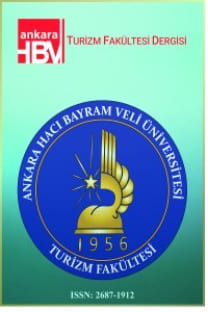TÜRK KUŞ GÖZLEMCİLERİNİN DESTİNASYON SEÇİMİNİ ETKİLEYEN DESTİNASYON NİTELİKLERİNİN ÖNEMİ
Kuş gözlemciliği, bu faaliyetin yapılabildiği destinasyonlardaki turizm endüstrisinin önemli bir pazarını oluşturmaktadır. Bir destinasyonun nitelikleri, o destinasyona dönük çeşitli pazar bölümleri için farklı önem düzeylerine sahip olabilir. Bu çalışmada, Türkiye’deki kuş gözlemcilerinin çeşitli destinasyon özelliklerine verdikleri önem düzeyini belirlemek üzere Buhalis’in 2000: 98 önerdiği 6A modeli kullanılmıştır. Araştırmada veriler geliştirilen anket formu ile toplanmıştır. Anket formu, internet aracılığıyla ve yüz yüze görüşme yöntemi ile uygulanmıştır. 2005 yılında yapılan veri toplama süreci sonunda, Türkiye’deki kuş gözlemcilerinden 88’i araştırmaya katılmıştır. Elde edilen verilerden, kuş gözlemcilerinin faaliyeti yapacakları alanın milli parklara yakın olmasına, temiz havaya sahip olmasına ve bu alanlarda doğanın hissedilebilmesine oldukça önem verdikleri anlaşılmaktadır. Öte yandan, kuş gözlemcilerinin, ulaşımı kolay, yeme-içme ve konaklama tesislerine sahip olan, rehberlik, güvenlik ve sağlık hizmetlerinin sunulduğu destinasyonları daha çok tercih edecekleri belirlenmiştir. Ayrıca, kuş gözlemcilerinin bu faaliyeti yaparlarken, doğaya dayalı ve kuşlara ilgili diğer faaliyetleri de yaptıkları anlaşılmıştır
Anahtar Kelimeler:
Kuş gözlemciliği, destinasyon nitelikleri, Türk kuş gözlemcileri, Türkiye
IMPORTANCE OF DESTINATION ATTRIBUTES ATTRIBUTES AFFECTING DESTINATION CHOICE OF AFFECTING DESTINATION CHOICE OF TURKISH BIRDWATCHERS
Birdwatchers become a market segment for tourism industry, especially for the destination where birdwatching activity might be conducted. Destination attributes may have different weights for different market segments. In this article, Buhalis’ 2000: 98 6A’s framework for destination attributes was used to determine the importance levels. Data were collected via a questionnaire and 88 birdwatchers joined in the research through internet and face to face in 2005. It was determined that they assign great importance to feel nature with clean air, especially the destinations located in national parks. Their favorite destinations are those with easy access, with food and beverage outlets, with guiding services and with accommodation facilities, supported by security and health services. Turkish birdwatchers like doing nature based activities and bird related activities while they are watching the birds
Keywords:
Birdwatching, destination attributes, Turkish birdwatchers, Turkey,
___
- ARMY, Shen. (1999), Birdwatching Gains in Popularity and Worth Big Bucks, New Straits Times (Malaysia), 19 October 1999.
- BUHALIS, Dimitris. (2000), Marketing the Competitive Destination of Future, Tour- ism Management, (21): 97-116.
- EUBANKS, Ted., KERLINGER, Paul. and PAYNE, R. Howard. (1993), High Island, Texas, A Case Study in Avitourism, Birding, 25 (6): 415-420.
- HVENEGAARD, T. Glen. (2002), Birder Specialization Differences in Conservation Involvement, Demographics, and Motivations, Human Dimensions of Wild- life, 2002 (7): 21-36.
- KERLINGER, Paul. and BRETT, Jarett. (1995), Hawk Mountain Sanctuary: A Case Study of Birder Visitation and Birding Economics. In Knight, R. L.(Ed), Wildlife & Recreationists: Coexistence Through Management &Research.(pp. 271-281). Covelo, CA, USA: Island Press
- KIM, S. Samuel., SCOTT, David. and CROMPTON, John. L. (1997), An Exploration of the Relationships Among Social Psychological Involvement, Behavioral In- volvement, Commitment, and Future Intentions in the Context of Birdwatching, Journal of Leisure Research, 29 (3): 320-341.
- LAM, Terry. and HSU, Cathy. (2006), Predicting Behavioral Intention of Choosing A Travel Destination, Tourism Management, 2006 (27): 589-599.
- LEE, J. H. and SCOTT, D. (2004), Measuring Birding Specialization: A Confirmatory Factor Analysis, Leisure Sciences, 2004 (26): 245-260.
- NICOLAU, J. Luis. and MAS, Fransisco. J. (2004), Stoshastic Choice Analysis of Tourism Destinations, Valenciano de Investigaciones Económicas, 2004: 1-34.
- NOLAN, M., Justine. and. KELLER III F. Carl. (2006), Campfires, Cathedrals, and Casinos: Sociodemographic Variation and Perceptions of Tourist Destina- tions. Paper presented at the 2 Annual Meetings of the Society for Anthro- pological http//:www.cast.uark.edu/ar_tourism/content/Lastfreelist.pdf Savannah, GA, Retrieved July 24, 2006
- OMERZEL, G, Doris. (2006), Competitiveness of Slovenia as a Tourist Destination, Managing Global Transitions, 4 (2): 167-189
- PIKKEMAAT, Birgit., (2004), The Measurement of Destination Image: The Case of Austria. The Poznan University of Economics Review, 4 (1): 87-102
- SCOTT, David. and THIPGEN, Jack. (2003), Understanding the Birder as Tourist: Segmenting Visitors to the Texas Hummer/Bird celebration, Human Dimen- sions of Wildlife, 2003 (8): 199-218.
- SMITH, K. Cherie. (1996), Tourism Product Development: A Case Study of Wildlife Viewing in the Squamish Valley, Retrieved August, 16 June, 2005 from http://www.rem.sfu.ca/pdf/smith.pdf
- ŞEKERCIOĞLU, Ç. Hakkı. (2002), Impacts of Birdwathcing on Human and Avian Communities, Enviromental Conversation, 29 (3): 282-289.
- Tourism Tip Sheet: Birding, Retrieved December, 7, 2004 from.www.travel.state.tx.us/documents/birding_01127402705634712718.pdf.
- Important Bird Areas, Retrieved August, 22, 2005 from http://www.birdlife.org/action/science/sites
- Important Bird Areas of Turkey Retrieved August 14, 2005, from http://www.kustr.org/kustr.php?modul=kyazidev&id=38
- The Use of Wildlife Tourism as A Developmental Aid For Local Communities: A Case Study on Avitourism, Retrieved August 14, 2005, from http://www.birdsaustralia.org.au/Ppts
- U.S. Department of Interior Fish and Wildlife Service. National Survey of Fishing Hunting and Wildlife Associated Recreatio Retrieved August 9, 2005, from http://www.census.gov/prod/3/97pubs/fhw96nat.pdf
- ISSN: 2687-1912
- Yayın Aralığı: Yılda 2 Sayı
- Başlangıç: 1998
- Yayıncı: Ankara Hacı Bayram Veli Üniversitesi
Sayıdaki Diğer Makaleler
Akdeniz Ülkelerine Yönelik Uluslararası Turizm Hareketleri
Ali Dursun AYDIN, Murat TURGUT, Rıdvan BAYIRLI
Nostaljinin Pazar Bölümleme Değişkeni Olarak Kullanılması Üzerine Bir Araştırma
TÜRK KUŞ GÖZLEMCİLERİNİN DESTİNASYON SEÇİMİNİ ETKİLEYEN DESTİNASYON NİTELİKLERİNİN ÖNEMİ
Çalışma Ortamı Koşullarının İşletme Verimliliği Üzerine Etkisi
ÖRGÜTSEL BAĞLILIK İLE İŞGÖREN PERFORMANSI İLİŞKİSİNİ İNCELEMEYE YÖNELİK BİR ALAN ARAŞTIRMASI
Konaklama İşletmelerinin Değerini Etkileyen Faktörlerin Analizi ve Değerleme Yaklaşımları
